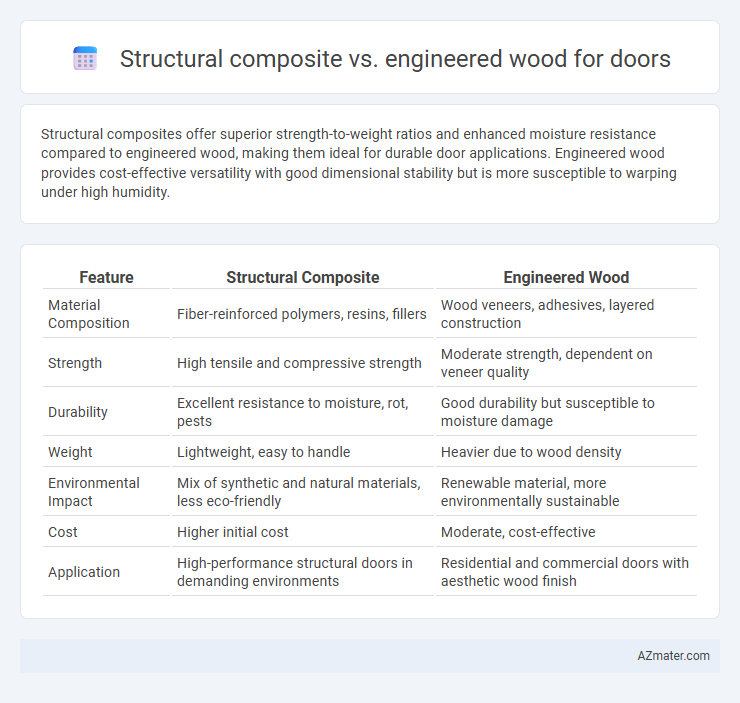Structural composites offer superior strength-to-weight ratios and enhanced moisture resistance compared to engineered wood, making them ideal for durable door applications. Engineered wood provides cost-effective versatility with good dimensional stability but is more susceptible to warping under high humidity.
Table of Comparison
| Feature | Structural Composite | Engineered Wood |
|---|---|---|
| Material Composition | Fiber-reinforced polymers, resins, fillers | Wood veneers, adhesives, layered construction |
| Strength | High tensile and compressive strength | Moderate strength, dependent on veneer quality |
| Durability | Excellent resistance to moisture, rot, pests | Good durability but susceptible to moisture damage |
| Weight | Lightweight, easy to handle | Heavier due to wood density |
| Environmental Impact | Mix of synthetic and natural materials, less eco-friendly | Renewable material, more environmentally sustainable |
| Cost | Higher initial cost | Moderate, cost-effective |
| Application | High-performance structural doors in demanding environments | Residential and commercial doors with aesthetic wood finish |
Introduction to Door Material Choices
Structural composite and engineered wood are popular door material options that offer distinct benefits in durability and design flexibility. Structural composite doors provide superior resistance to moisture, warping, and impact, making them ideal for exterior applications. Engineered wood doors combine natural wood veneers with manufactured core materials, delivering enhanced stability and aesthetic appeal while minimizing the weaknesses of solid wood.
What Are Structural Composites?
Structural composites are materials made by combining two or more constituent materials with different properties to produce a product with enhanced strength and durability, commonly used in door construction for their superior load-bearing capacity. Engineered wood, a subset of structural composites, is manufactured by bonding wood fibers, veneers, or particles with adhesives under heat and pressure, offering improved stability and resistance to warping compared to solid wood. These composites provide optimized performance in doors, balancing weight, strength, and environmental resistance for longer-lasting, high-quality installations.
Understanding Engineered Wood
Engineered wood offers superior dimensional stability and resistance to warping compared to structural composites, making it ideal for door applications where precision and durability are crucial. Composed of layered veneers or wood fibers bonded with adhesives, engineered wood combines the natural aesthetics of solid wood with enhanced strength and moisture resistance. This material excels in maintaining structural integrity under varying environmental conditions, providing a reliable and cost-effective alternative for high-performance doors.
Key Differences Between Structural Composites and Engineered Wood
Structural composites for doors consist of layers of wood fibers combined with resins under heat and pressure, providing superior strength, moisture resistance, and dimensional stability compared to engineered wood. Engineered wood, made by bonding wood veneers, strands, or particles with adhesives, offers affordability and ease of customization but may lack the durability and environmental resilience of structural composites. Key differences include the manufacturing process, structural performance, and resistance to warping and decay, making structural composites ideal for high-performance door applications.
Strength and Durability Comparison
Structural composites like laminated veneer lumber (LVL) offer superior strength and dimensional stability compared to engineered wood products such as plywood or medium-density fiberboard (MDF) when used for doors. LVL demonstrates higher load-bearing capacity and resistance to warping, making it ideal for heavy or exterior door applications requiring long-term durability. Engineered wood doors provide decent strength at a lower cost but are more susceptible to moisture damage and structural deformation over time.
Moisture and Weather Resistance
Structural composites like fiberglass offer superior moisture resistance and weather durability compared to engineered wood, which tends to absorb water and warp over time. Fiberglass doors maintain dimensional stability in high humidity and extreme climates, minimizing the risk of swelling or rotting. Engineered wood doors require regular maintenance and sealants to protect against moisture infiltration and deterioration from weather exposure.
Aesthetic Versatility and Design Options
Structural composite offers extensive aesthetic versatility with its ability to mimic natural wood grains and finishes while providing consistent quality and durability. Engineered wood provides a wide range of design options through customizable veneers and stains but may have limitations in grain variation compared to structural composites. Both materials support intricate panel designs and smooth surfaces, enhancing door styles from traditional to modern.
Environmental Impact and Sustainability
Structural composites often contain synthetic resins and adhesives derived from non-renewable petrochemicals, leading to higher environmental impact compared to engineered wood, which typically uses natural wood fibers and eco-friendly binders. Engineered wood products, such as cross-laminated timber (CLT) and laminated veneer lumber (LVL), promote sustainable forestry by optimizing wood use and reducing waste, while also sequestering carbon during their lifecycle. Selecting engineered wood for doors supports circular economy principles and lowers the carbon footprint, making it a more sustainable choice over traditional structural composites.
Cost Efficiency and Long-Term Value
Structural composite doors generally offer higher initial cost efficiency due to the use of advanced materials that enhance durability and reduce maintenance expenses. Engineered wood doors provide strong long-term value through their natural aesthetic appeal and excellent resistance to warping and cracking, making them reliable over extended periods. Choosing between the two depends on balancing upfront investment with desired longevity and maintenance requirements in door applications.
Choosing the Best Material for Your Door
Structural composite offers superior strength, moisture resistance, and dimensional stability, making it ideal for exterior doors exposed to weather. Engineered wood provides a cost-effective option with good aesthetic appeal and decent durability for interior doors or low-moisture environments. Selecting the best material depends on factors like climate, budget, and desired door performance, with structural composites favored for longevity and engineered wood suitable for style and affordability.

Infographic: Structural composite vs Engineered wood for Door
 azmater.com
azmater.com